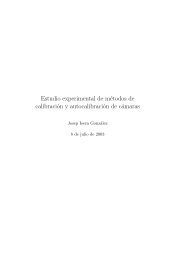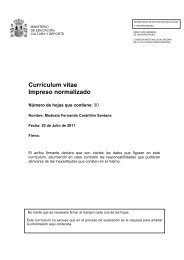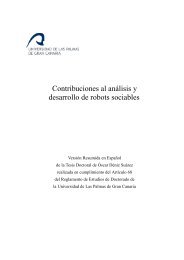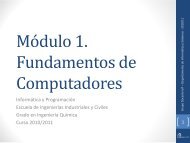- Page 1: Departamento de Informática y Sist
- Page 7: To my family and Gloria
- Page 10 and 11: Gobierno de Canarias, Ministerio de
- Page 12 and 13: 5.2.3 Implementation . . . . . . .
- Page 15 and 16: List of Figures 1.1 Abilities vs. l
- Page 17 and 18: 5.13 T means tracking and CS Candid
- Page 19 and 20: List of Tables 1.1 The eight human
- Page 21 and 22: Abstract A relatively new area for
- Page 23 and 24: Publications This thesis is based o
- Page 25 and 26: Chapter 1 Introduction "Man is by n
- Page 27 and 28: CHAPTER 1. INTRODUCTION characteris
- Page 29 and 30: CHAPTER 1. INTRODUCTION robots: ➔
- Page 31 and 32: CHAPTER 1. INTRODUCTION respect to
- Page 33 and 34: CHAPTER 1. INTRODUCTION attention,
- Page 35: Chapter 2 The Case of Social Roboti
- Page 39 and 40: CHAPTER 2. THE CASE OF SOCIAL ROBOT
- Page 41 and 42: CHAPTER 2. THE CASE OF SOCIAL ROBOT
- Page 43 and 44: CHAPTER 2. THE CASE OF SOCIAL ROBOT
- Page 45 and 46: CHAPTER 2. THE CASE OF SOCIAL ROBOT
- Page 47 and 48: CHAPTER 2. THE CASE OF SOCIAL ROBOT
- Page 49 and 50: Chapter 3 Approach and Architecture
- Page 51 and 52: CHAPTER 3. APPROACH AND ARCHITECTUR
- Page 53 and 54: CHAPTER 3. APPROACH AND ARCHITECTUR
- Page 55 and 56: CHAPTER 3. APPROACH AND ARCHITECTUR
- Page 57 and 58: CHAPTER 3. APPROACH AND ARCHITECTUR
- Page 59 and 60: CHAPTER 3. APPROACH AND ARCHITECTUR
- Page 61 and 62: CHAPTER 3. APPROACH AND ARCHITECTUR
- Page 63 and 64: CHAPTER 3. APPROACH AND ARCHITECTUR
- Page 65 and 66: CHAPTER 3. APPROACH AND ARCHITECTUR
- Page 67 and 68: CHAPTER 3. APPROACH AND ARCHITECTUR
- Page 69 and 70: Chapter 4 Hardware Overview "Your f
- Page 71 and 72: CHAPTER 4. HARDWARE OVERVIEW 4.1 Ha
- Page 73 and 74: CHAPTER 4. HARDWARE OVERVIEW Figure
- Page 75 and 76: CHAPTER 4. HARDWARE OVERVIEW Figure
- Page 77 and 78: CHAPTER 4. HARDWARE OVERVIEW Each m
- Page 79 and 80: Chapter 5 Perception "I’ve seen t
- Page 81 and 82: CHAPTER 5. PERCEPTION Figure 5.1: T
- Page 83 and 84: CHAPTER 5. PERCEPTION Figure 5.3: E
- Page 85 and 86: CHAPTER 5. PERCEPTION we could dist
- Page 87 and 88:
CHAPTER 5. PERCEPTION themaximum is
- Page 89 and 90:
CHAPTER 5. PERCEPTION Figure 5.7: E
- Page 91 and 92:
CHAPTER 5. PERCEPTION Classify cues
- Page 93 and 94:
CHAPTER 5. PERCEPTION Figure 5.10:
- Page 95 and 96:
CHAPTER 5. PERCEPTION 5.3 Audio-Vis
- Page 97 and 98:
CHAPTER 5. PERCEPTION modules, inst
- Page 99 and 100:
CHAPTER 5. PERCEPTION each angle we
- Page 101 and 102:
CHAPTER 5. PERCEPTION Figure 5.12:
- Page 103 and 104:
CHAPTER 5. PERCEPTION hypothesis is
- Page 105 and 106:
CHAPTER 5. PERCEPTION M4.- Pattern
- Page 107 and 108:
CHAPTER 5. PERCEPTION Figure 5.15:
- Page 109 and 110:
CHAPTER 5. PERCEPTION nods and shak
- Page 111 and 112:
CHAPTER 5. PERCEPTION effect of thi
- Page 113 and 114:
CHAPTER 5. PERCEPTION effects of am
- Page 115 and 116:
CHAPTER 5. PERCEPTION image decreas
- Page 117 and 118:
CHAPTER 5. PERCEPTION with an incre
- Page 119 and 120:
CHAPTER 5. PERCEPTION However, we a
- Page 121 and 122:
CHAPTER 5. PERCEPTION where y0 is t
- Page 123 and 124:
CHAPTER 5. PERCEPTION be distinguis
- Page 125 and 126:
CHAPTER 5. PERCEPTION in the sense
- Page 127 and 128:
CHAPTER 5. PERCEPTION a) b) c) d) F
- Page 129 and 130:
CHAPTER 5. PERCEPTION the habituati
- Page 131 and 132:
Chapter 6 Action "CHRISTOF: We’ve
- Page 133 and 134:
CHAPTER 6. ACTION Expression: "Surp
- Page 135 and 136:
CHAPTER 6. ACTION 6.1.3 Implementat
- Page 137 and 138:
CHAPTER 6. ACTION Figure 6.3: Facia
- Page 139 and 140:
CHAPTER 6. ACTION c α error 0 o 0.
- Page 141 and 142:
CHAPTER 6. ACTION fear anger sorrow
- Page 143 and 144:
CHAPTER 6. ACTION However, we belie
- Page 145 and 146:
Chapter 7 Behaviour "A good name, l
- Page 147 and 148:
CHAPTER 7. BEHAVIOUR used defines t
- Page 149 and 150:
CHAPTER 7. BEHAVIOUR step environme
- Page 151 and 152:
CHAPTER 7. BEHAVIOUR Predicate Desc
- Page 153 and 154:
CHAPTER 7. BEHAVIOUR Action Descrip
- Page 155 and 156:
CHAPTER 7. BEHAVIOUR Name Action to
- Page 157 and 158:
CHAPTER 7. BEHAVIOUR ➔ Basic emot
- Page 159 and 160:
CHAPTER 7. BEHAVIOUR [Reilly, 1996]
- Page 161 and 162:
Chapter 8 Evaluation and Discussion
- Page 163 and 164:
CHAPTER 8. EVALUATION AND DISCUSSIO
- Page 165 and 166:
CHAPTER 8. EVALUATION AND DISCUSSIO
- Page 167 and 168:
CHAPTER 8. EVALUATION AND DISCUSSIO
- Page 169 and 170:
CHAPTER 8. EVALUATION AND DISCUSSIO
- Page 171 and 172:
CHAPTER 8. EVALUATION AND DISCUSSIO
- Page 173 and 174:
CHAPTER 8. EVALUATION AND DISCUSSIO
- Page 175 and 176:
CHAPTER 8. EVALUATION AND DISCUSSIO
- Page 177 and 178:
CHAPTER 8. EVALUATION AND DISCUSSIO
- Page 179 and 180:
Chapter 9 Conclusions and Future Wo
- Page 181 and 182:
CHAPTER 9. CONCLUSIONS AND FUTURE W
- Page 183 and 184:
CHAPTER 9. CONCLUSIONS AND FUTURE W
- Page 185 and 186:
CHAPTER 9. CONCLUSIONS AND FUTURE W
- Page 187 and 188:
CHAPTER 9. CONCLUSIONS AND FUTURE W
- Page 189 and 190:
Appendix A CASIMIRO’s Phrase File
- Page 191 and 192:
APPENDIX A. CASIMIRO’S PHRASE FIL
- Page 193 and 194:
APPENDIX A. CASIMIRO’S PHRASE FIL
- Page 195 and 196:
APPENDIX A. CASIMIRO’S PHRASE FIL
- Page 197 and 198:
Bibliography [Adams et al., 2000] B
- Page 199 and 200:
BIBLIOGRAPHY [Bruce et al., 2001] A
- Page 201 and 202:
BIBLIOGRAPHY [Driscoll et al., 1998
- Page 203 and 204:
BIBLIOGRAPHY [Hernández et al., 20
- Page 205 and 206:
BIBLIOGRAPHY [Kjeldsen, 2001] R. Kj
- Page 207 and 208:
BIBLIOGRAPHY [Martin et al., 2000]
- Page 209 and 210:
BIBLIOGRAPHY [Oviatt, 2000] S. Ovia
- Page 211 and 212:
BIBLIOGRAPHY [Schulte et al., 1999]
- Page 213 and 214:
BIBLIOGRAPHY [Tyrrell, 1993] T. Tyr
- Page 215 and 216:
Index absolute pitch, 16 action sel
- Page 217:
INDEX proprioception, 39 prosopagno










